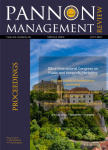12 / 1 (July 2023)
Latest issue
Latest issue

Author(s)  | Title  | Year  | |
|---|---|---|---|
  | Dorottya Bodnár; Melinda Jászberényi; Katalin Ásványi | 2017 (6/3) | |
Abstract: The paper summarizes the results of the research executed in 2016 among 15 museums and exhibitions of different size in Budapest. The research involved deep interviews with museum leaders and observation of the institutes’ exhibitions and other activities. The aspects of the research were target groups, method of interpretation, interactivity, marketing, involvement of volunteers, etc. Four important factors seem to influence visitor numbers the most, such as location, historic building of the museum itself, general attribute of the topic treated and the level of interactivity. Results were analysed in the frame of new museology, a new paradigm, in relation with museum development and operation which have to be taken into consideration by all leaders in these attractions. Museums have the responsibility of sensitization of the public regarding the importance of different topics and the value of heritage, treated among the walls. If they do not accept the methods of interpretation fitted to new generations or to anyone living in the rushing world of the 21st century, then they won’t be able to attract enough visitors for their sustainable operation and for the fulfilment of their goals. Sustainability of museums was evaluated on the basis of environmental, economic and socio-cultural points of view. Mostly all factors, analysed during the research affect one or more of the abovementioned aspects of sustainability. | |||
  | Katalin Ásványi; Melinda Jászberényi | 2017 (6/3) | |
Abstract: Festival tourism is a dynamically growing sector of tourism, the number of festival visitors are increasing, and the travel motivations for this reason are strengthening. The festivals use and shape their natural and social environments and they play an important role in the environmental, economic and social sustainability of their regions. Taking into account the tourism effects of festivals, it is important to interpret the issue of sustainability. Our main research questions are: How does the festival affect the lives of the local community? What does it cause in the economy of the region? How does it change the immediate environment? The research has two parts. Firstly, Hungarian festivals are analysed and evaluated on the basis of the information available on their websites. There are seven pre-determined criteria factors: 1. the quality of locals’ lives; 2. change and enlargement of employment structures; 3. change of value-system; 4. development of individual, family and social relationships; 5. expressions of creativity; 6. local community organizations; and 7. change and preservation of traditions. The second part of the research was a series of interviews, where the main criteria were the same seven ones. The aim of the study is to highlight the most important points in terms of sustainability and to present positive examples of how festivals can positively contribute to sustainability issues. | |||


